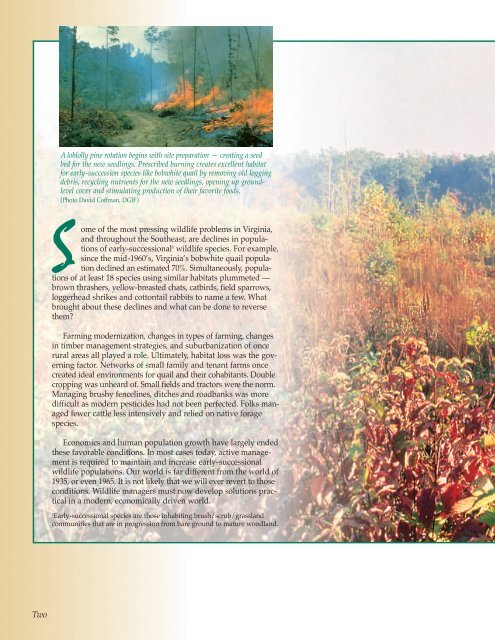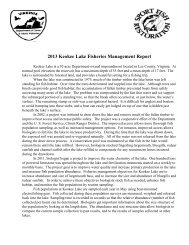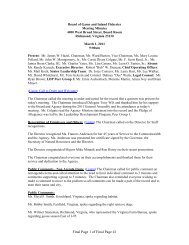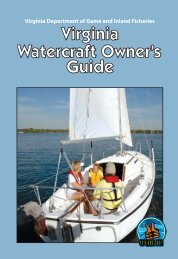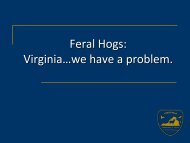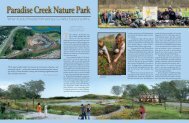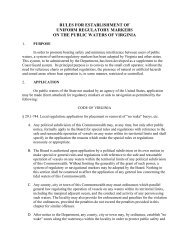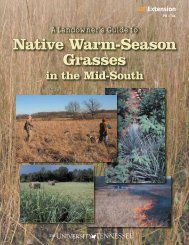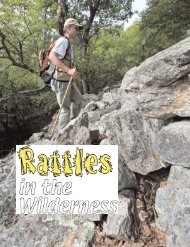Managing Pines for Profit and Wildlife - Virginia Department of ...
Managing Pines for Profit and Wildlife - Virginia Department of ...
Managing Pines for Profit and Wildlife - Virginia Department of ...
You also want an ePaper? Increase the reach of your titles
YUMPU automatically turns print PDFs into web optimized ePapers that Google loves.
A loblolly pine rotation begins with site preparation — creating a seedbed <strong>for</strong> the new seedlings. Prescribed burning creates excellent habitat<strong>for</strong> early-succession species like bobwhite quail by removing old loggingdebris, recycling nutrients <strong>for</strong> the new seedlings, opening up groundlevelcover <strong>and</strong> stimulating production <strong>of</strong> their favorite foods.(Photo David C<strong>of</strong>fman, DGIF)Some <strong>of</strong> the most pressing wildlife problems in <strong>Virginia</strong>,<strong>and</strong> throughout the Southeast, are declines in populations<strong>of</strong> early-successional 1 wildlife species. For example,since the mid-1960’s, <strong>Virginia</strong>’s bobwhite quail populationdeclined an estimated 70%. Simultaneously, populations<strong>of</strong> at least 18 species using similar habitats plummeted —brown thrashers, yellow-breasted chats, catbirds, field sparrows,loggerhead shrikes <strong>and</strong> cottontail rabbits to name a few. Whatbrought about these declines <strong>and</strong> what can be done to reversethem?Farming modernization, changes in types <strong>of</strong> farming, changesin timber management strategies, <strong>and</strong> suburbanization <strong>of</strong> oncerural areas all played a role. Ultimately, habitat loss was the governingfactor. Networks <strong>of</strong> small family <strong>and</strong> tenant farms oncecreated ideal environments <strong>for</strong> quail <strong>and</strong> their cohabitants. Doublecropping was unheard <strong>of</strong>. Small fields <strong>and</strong> tractors were the norm.<strong>Managing</strong> brushy fencelines, ditches <strong>and</strong> roadbanks was moredifficult as modern pesticides had not been perfected. Folks managedfewer cattle less intensively <strong>and</strong> relied on native <strong>for</strong>agespecies.Economics <strong>and</strong> human population growth have largely endedthese favorable conditions. In most cases today, active managementis required to maintain <strong>and</strong> increase early-successionalwildlife populations. Our world is far different from the world <strong>of</strong>1935, or even 1965. It is not likely that we will ever revert to thoseconditions. <strong>Wildlife</strong> managers must now develop solutions practicalin a modern, economically driven world.1Early-successional species are those inhabiting brush/scrub/grassl<strong>and</strong>communities that are in progression from bare ground to mature woodl<strong>and</strong>.Two


